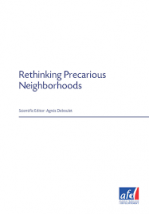Rethinking precarious neighborhoods

This edited collection discusses the notion of “precarious neighborhoods”. This is part of a strand of research that attempts to go beyond the legal/illegal divide and the dualistic formal/informal vision (pages 13 and 15). In particular, it refers to the “fragility of built structures or to the economic, social, and even environmental difficulties that stem from living on city fringe areas”. This primarily relates to insecurity of tenure, and connects to demolition and eviction threats and the strong resistance that can subsequently arise (page 15).
This volume comprises 13 chapters and brings together the work of 17 researchers, who bring empirical knowledge from France, Spain, India, Lebanon, Senegal and South Africa (pages 9 and 29). As they contribute to rethinking precarious neighbourhoods, the final analysis in each chapter highlights how “the question of developing interventions and policies hinges on the political grammar of social and spatial inequality, and on the imperative to focus all our attention on the cognitive resources of populations” (page 29).
The volume’s editor, Agnès Deboulet, starts with an Introduction. The main body of Rethinking Precarious Neighbourhoods is then structured in three parts and is concluded by Armelle Choplin, who rethinks the future city in light of the book’s conversation.
Part One is entitled “Precarious neighbourhoods: building a social fact, a paradigm, and critical feedback”, and presents four chapters that look at the important features of focusing on the competencies of populations (page 29). Janice Perlman considers concepts and consequence of marginality; David Satterthwaite revisits low-income housing sub-markets in relation to finding a place in the city; Rafael Soares Goncalves draws upon the favelas of Rio de Janeiro to assess how informal settlements are not only at the margin of the city, but also at the margin of history; and finally, Mona Fawaz investigates the practice of informality as exception through the case of building permit provision in Beirut.
In Part Two, “Security of land tenure and housing markets: experiences, failures and learnings”, the main focus across its five chapters is the fundamental question of land and security of tenure (page 29). Valérie Clerc draws upon comparative analysis of urban policy in Beirut, Phnom Penh and Damascus to explore the impact of land (its representation and competition) upon precarious settlements; Alan Gilbert argues for expanding housing policies in the Global South to encompass more rental housing; Serigne Mansour Tall reviews informal settlements in Dakar and proceeds to discuss the political, institutional, legal and operational issues for upgrading such settlements in Senegal (page 136); Diana Mitlin examines key challenges facing the integration of precarious settlements within the city fabric, and identifies alternative approaches for addressing the needs of these inhabitants (pages 147 and 154); and to end Part Two, Thomas Aguilera compares Paris and Madrid to explain the sidelining of slum interventions in Europe.
“Collective mobilization: knowledge and learnings” is the title of Part Three. Across its four chapters this seeks not only to renew how we perceive precarious neighbourhoods, but also to offer ways forward to reformulating intervention practices and principles (page 29). Véronique Dupont draws upon the experience of Delhi and other Indian cities to examine the communication and participation challenges in precarious settlement restructuring projects; Marie Huchzermeyer looks at how informal settlements are at the intersection of urban planning and rights and identifies advances through the case of judicialization in South Africa; Bhuvaneswari Raman and others illustrate how an Indian squatter settlement gained legal status through the bottom-up process of participation; and to close, Barbara Lipietz and Caroline Newton adopt a different entry point for rethinking precarious settlements.
This volume is relevant for urban planners, policymakers and practitioners, especially but not limited to those interacting with precarious neighbourhoods in the global South. It is also, as Lipietz and Newton point out, valuable reading for teachers and students of architecture, planning and urban studies.
Available from: https://www.researchgate.net/publication/312330705_Rethinking_precarious...
Book note prepared by Hannah Keren Lee
Search the Book notes database
Our Book notes database contains details and summaries of all the publications included in Book notes since 1993 - with details on how to obtain/download.
Use the search form above, or visit the Book notes landing page for more options and latest content.
For a searchable database for papers in Environment and Urbanization, go to http://eau.sagepub.com/

